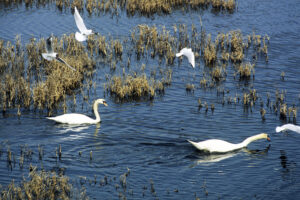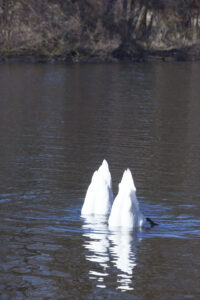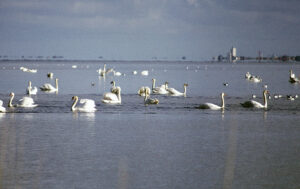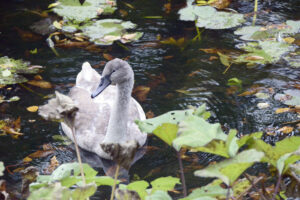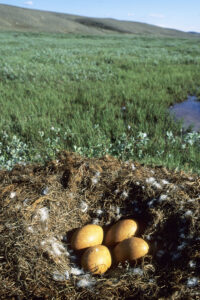Swans
Grazing whooper swan, Lake Hornborga, Sweden. (Photo copyright © by Kaj Halberg)
Mute swan on its nest, Møn, Denmark. (Photo copyright © by Kaj Halberg)
Black-necked swan, Carrizal Bajo, Llanos de Challe National Park, Chile. (Photo copyright © by Kaj Halberg)
Swans constitute a small genus, Cygnus, of 6 long-necked birds, distributed on all continents except Antarctica. Genetic research indicates that the coscoroba swan (Coscoroba coscoroba) of South America is not a true swan, but more closely related to geese or shelducks.
When Swedish naturalist Carl Linnaeus (1707-1778) in 1758 published the 10th edition of Systema Naturae, he named the whooper swan Anas cygnus, the specific name being a Latinized form of the classical Greek word for swans, kyknos. In 1764, swans were moved to the genus Cygnus, instigated by French naturalist François Alexandre Pierre de Garsault (1693-1778).
Swans are the largest members of the family Anatidae (ducks, geese, and swans), and they are among the largest flying birds, reaching a length of over 1.5 m and weighing up to 15 kg, with a wingspan of more than 3 m. The largest species was the extinct Cygnus falconeri, a flightless giant that once lived on islands in the Mediterranean.
Adult male swans are called cobs, females pens, and young swans cygnets. A flock of swans is called a bevy or a wedge.
The name swan is derived from Indo-European swen (‘to sound’ or ‘to sing’), referring to the whooper swan (below).
Mute swan (Cygnus olor)
The mute swan, which may grow to 1.5 m long, is native to northern Europe, from southern Norway and southern Finland, southwards to southern France and Romania, and from Ireland eastwards to western Russia and Ukraine, and with patchy breeding occurrence in the Balkans, Turkey, and Central Asia, eastwards to southern Siberia, Mongolia, and northern China. It has also been introduced elsewhere, including North America, Australia, New Zealand, and South Africa.
In 1984, the mute swan was elected the national bird of Denmark – an appropriate choice, as it is very common. This was not always the case. In the 1800s, swans were hunted in Denmark, and by 1920, only three or four pairs were breeding in the vicinity of Copenhagen. Swans were protected in 1926, and the mute swan soon began spreading across the country.
In the breeding season, swans are usually strongly territorial, but in areas, where the living conditions are especially favourable, it may change behaviour and in some cases start breeding colony-like. One such case took place in Ringkøbing Fjord, western Jutland, Denmark, in the 1970s. A huge amount of nutrients from the surrounding rivers, especially Skjern Å, was led into the fjord, causing a strong increase in the growth of water plants, which constitute the preferred food of swans.
On three islets in the fjord, together called Klægbanken, the first breeding of mute swans took place in 1953, and in 1958 the number had risen to 10 pairs. In the following years, the number increased dramatically. In 1960, 74 nests were counted on the islets, and in 1969 181 nests, but only two years later, this number had more than doubled, and a maximum of 725 nests were counted in 1978. This development was surveyed in detail by a friend of mine, biology student Jörn Eskildsen. (Source: J. Eskildsen 1979. Kolonidannelse hos Knopsvane 1 & 2 (‘The forming of a colony of mute swans, 1 & 2’). – Master thesis, Copenhagen University)
When the forming of the colony took place, the swans in the fjord changed behaviour from being strongly territorial to breeding in colonies. In some cases, the nests were situated only a few metres from each other.
During a number of years, the breeding swans on Klægbanken constituted the largest ‘swan colony’ in the world, and 585 nests were still present in 1980. However, already the following year, the number had fallen to only 45 nests. This dramatic decrease was caused by a total collapse of the underwater vegetation in Ringkøbing Fjord in 1979 and the following years. The result of leading large amounts of nutrients into the fjord for several years was that water plants like widgeon grass (Ruppia) was overgrown by epiphytes, especially algae. This meant that in only a couple of years the fjord, as a feeding area for plant-eating birds, changed from being of enormous importance to being of minor importance.
Following an improved sewage treatment in the surrounding towns, the underwater vegetation in the fjord has become stabilized, causing the number of breeding mute swans on Klægbanken to increase again, and in 2024 the number was 229 pairs.
As opposed to the whooper swan (below), the mute swan is not very vocal, hence the appellation mute. Occasionally, it emits a spinning krrrrr, and in flight its wings produce a singing sound.
The specific name is the classical Latin term for swan.
In his fairy tale The Ugly Duckling, Danish poet Hans Christian Andersen (1805-1875) relates the fate of a cygnet, which is ostracized by its fellow fowl in a farmyard, where it has been hatched together with ducklings. It has to undergo much suffering, before it realizes that it has matured into a beautiful swan. In reality, this story is about the fate of Andersen himself.
Mute swan, Copenhagen, Denmark. (Photo copyright © by Kaj Halberg)
Preening mute swan, Møn, Denmark. (Photo copyright © by Kaj Halberg)
This one is stretching its neck, Møn. (Photo copyright © by Kaj Halberg)
Mute swan in a large growth of water-pinkweed (Persicaria amphibia), Lake Flyndersø, Jutland, Denmark. (Photo copyright © by Kaj Halberg)
This mute swan is resting on a rock, Lake Mälaren, Stockholm, Sweden. (Photo copyright © by Kaj Halberg)
Mute swans, seen as silhouettes, Albrunna, Öland, Sweden. (Photo copyright © by Kaj Halberg)
This pair of mute swans had entered a colony of black-headed gulls (Chroicocephalus ridibundus) and are now being mobbed by the gulls, Møn, Denmark. (Photo copyright © by Kaj Halberg)
Dabbling mute swans, River Gudenå, central Jutland, Denmark. (Photo copyright © by Kaj Halberg)
Incubating mute swans, Bornholm (top), and eastern Jutland, both Denmark. (Photos copyright © by Kaj Halberg)
Some mute swans build their nest in the most unlikely places. In these pictures, swans have occupied pontoons in a canal in Copenhagen, oblivious of passing people or tourist boats. (Photos copyright © by Kaj Halberg)
Nest of mute swan with eggs, Nature Reserve Tipperne, Ringkøbing Fjord, Denmark. The eggs vary in colour, from bluish-green to pure white. (Photo copyright © by Kaj Halberg)
Occasionally, mute swans lay eggs in nests of other birds, in this case aest of common eider (Somateria mollissima), eastern Jutland, Denmark. (Photo copyright © by Kaj Halberg)
Newly hatched cygnets, Nature Reserve Klægbanken, Ringkøbing Fjord, Denmark. (Photo copyright © by Kaj Halberg)
Mute swans can be quite aggressive towards other birds. This one is threatening a greylag goose (Anser anser) with goslings, Copenhagen, Denmark. (Photo copyright © by Kaj Halberg)
Swans can also be aggressive towards humans. This female on Klægbanken is unwilling to leave her nest. (Photo copyright © by Kaj Halberg)
Aerial photograph of Klægbanken, Ringkøbing Fjord, May 14, 1977. For a number of years during the 1970s and 1980s, the largest mute swan ‘colony’ in the world was found on these islets, with a maximum of 725 nests. The white dots are incubating swans – note how close the nests are built. The growth of reeds (Phragmites australis) has been harvested mechanically. (Photo copyright © by Kaj Halberg)
These mute swans are lying in the fjord near Klægbanken, waiting for us to disappear. (Photo copyright © by Kaj Halberg)
Biology student Jörn Eskildsen marks the eggs in a swan’s nest on Klægbanken with a speedmarker to follow its hatching succes. (Photo copyright © by Kaj Halberg)
Here, Jörn makes notes about the hatching succes in a nest. (Photo copyright © by Kaj Halberg)
Jörn, banding a mute swan with a foot ring as well as a coloured plastic collar with a serial number. He caught a large number of swans in Ringkøbing Fjord, when they were moulting and unable to fly. (Photo copyright © by Kaj Halberg)
Mute swans and a few whooper swans, grazing on fields in winter, near Stege Nor, Møn, Denmark. (Photos copyright © by Kaj Halberg)
In severe winters, many starving water birds gather in harbours, where conditions are often less harsh than in open areas. This woman in Lausanne, Switzerland, is feeding various bird species, including mute swans, coots (Fulica atra), tufted ducks (Aythya fuligula), black-headed gulls (Chroicocephalus ridibundus), and feral pigeons (Columba livia). (Photo copyright © by Kaj Halberg)
These mute swans are resting on the ice-covered Roskilde Fjord, Zealand, Denmark, waiting for milder weather. (Photo copyright © by Kaj Halberg)
In these pictures, numerous mute swans are gathered around a crack in the sea ice, near the island of Møn, Denmark. Some have already succumbed, others are dying. The dark spots on the ice are excreta from the birds. (Photos copyright © by Kaj Halberg)
“The Ugly Duckling.” – This young mute swan is feeding in a moat around Nyborg Castle, Funen, Denmark. The plant in the foreground is butterbur (Petasites hybridus), in the background floating leaves of white waterlily (Nymphaea alba). (Photo copyright © by Kaj Halberg)
Whooper swan (Cygnus cygnus)
This swan is of similar size as the mute swan, but is easily identified by its bill, which is black towards the tip and strongly yellow near the base. It also has yellow skin between the bill and the eye. The neck is held more erect than the mute swan.
It was named due to its very powerful, sonorous call, and often several birds call in unison. Incidentally, its name is pronounced ‘hooper swan’, although the word whooper alone is pronounced ‘wooper’. In his book Ornithologiae libri tres (‘Ornithology, Book Three’), from 1676, English naturalist Francis Willughby (1635-1672) refers to the whooper swan as “the Elk, Hooper, or wild Swan”.
It is a widespread and common bird, breeding in shallow lakes and forest bogs, from Iceland eastwards across Scandinavia, Finland, and northern Asia to Kamchatka, southwards to Kazakhstan, Mongolia, and extreme northern China.
During the last 50 years, it has been expanding southwards. Today, it is a common breeding bird in southern Sweden, and breeds regularly in Ireland, Scotland, Germany, Denmark, Poland, Latvia, and Estonia.
It is partly resident in Iceland, Norway, and Sweden, but the vast majority of the population is migratory, spending the winter in western and southern Europe, around the Black, Caspian, and Aral Seas, in eastern China, and in Korea and Japan. In Denmark, up to 60,000 birds spend the winter, and the country constitutes one of the most important wintering areas for the species in the world.
Portrait of a whooper swan, Lake Hornborga, Sweden. (Photo copyright © by Kaj Halberg)
Whooper swans, Reykjavik, Iceland. (Photo copyright © by Kaj Halberg)
Whooper swans, Lake Hornborga, Sweden. (Photo copyright © by Kaj Halberg)
This whooper swans is stretching its wings, Lake Hornborga. The birds in the background are Canada geese (Branta canadensis), an escaped species, which has formed huge feral populations in Sweden. (Photo copyright © by Kaj Halberg)
Preening whooper swans, Lake Hornborga. (Photo copyright © by Kaj Halberg)
This whooper swan is feeding in shallow water, Lake Hornborga. (Photos copyright © by Kaj Halberg)
Whooper swans, grazing on land, Lake Hornborga. (Photo copyright © by Kaj Halberg)
A family of whooper swans, calling in unison, Lake Hornborga. In April, when these pictures were taken, the cygnets from the previous summer were still accepted by their parents, but once the parents have reached their breeding site, they will be chased away. (Photos copyright © by Kaj Halberg)
Incubating whooper swan, near Höfn, southern Iceland. (Photo copyright © by Kaj Halberg)
Nest of whooper swan, Aldeyjardal, Iceland. Newly laid eggs are white, but these have become ochre-coloured from the nesting material. (Photo copyright © by Kaj Halberg)
A family of whooper swans in winter, central Jutland, Denmark. (Photo copyright © by Kaj Halberg)
Tundra swan and Bewick’s swan (Cygnus columbianus)
This smallish species reaches a length of about 1.2 m, having a wingspan up to 2.1 m, and weighing up to 6.5 kg. Most authorities recognize two subspecies, the whistling swan (ssp. columbianus), which lives in North America, and Bewick’s swan (ssp. bewickii), which is found in Eurasia. Some authorities regard the two subspecies as separate species. They differ in bill colour, Bewick’s swan having a fairly large patch of yellow skin at the base of the bill, wheareas the whistling swan has dark skin with only a small yellow spot at the base.
Bewick’s swan resembles the whooper swan (above), but is notably smaller, and the yellow patch at the base of the bill is smaller.
If you regard these birds as a single species, it breeds in Arctic areas of Alaska and Canada, and in the northernmost parts of Siberia. The wintering areas of the whistling swan include several separate areas in western Canada, United States, and Mexico, and the central part of the Atlantic coast. Eastern populations of Bewick’s swan spend the winter in eastern China, Korea, and Japan, whereas western populations migrate to western Europe.
The total population of the whistling swan is around 200,000, and is slightly increasing. The population of Bewick’s swan is much smaller, less than 50,000, but is probably stable.
In 1803, American President Thomas Jefferson (1743-1826) ordered two army captains, Meriwether Lewis (1774-1809) and William Clark (1770-1838), to undertake an expedition across the western part of the North American continent, from the Mississippi River to the Pacific Ocean. During their 3-year long expedition, Lewis described countless plants and animals, many of which were new to science, including the tundra swan. The whistle-like call of the bird prompted Lewis to name it whistling swan.
The specific name refers to the Columbia River, the type locality of the whistling swan.
Bewick’s swan was named in 1830 by English naturalist William Yarrell (1784-1856) in honour of English engraver Thomas Bewick (1753-1828), who specialized in illustrations of birds and other animals. He is best known for the work A History of British Birds, which contains many fine wood engravings. He also illustrated several editions of Aesop’s Fables.
Tundra swan, Klamath National Wildlife Refuge, California. (Photo copyright © by Kaj Halberg)
Black swan (Cygnus atratus)
This large swan is black with a brownish tinge, except the wings, which are whitish. However, the whitish colour is only seen in flight. It is native to the major part of Australia, but has been introduced to many other countries, including New Zealand, England, United States, Japan, and China, often forming feral populations.
The global population is estimated at over 500,000 individuals.
The black swan is depicted on the state flag and the coat of arms of Western Australia.
The bird plays a significant role in the mythology of the Nyungar people of south-western Australia. It is said that the ancestors of the Nyungar were once black swans which were transformed to people.
The specific name is Latin, meaning ‘clothed in mourning’, derived from ater (‘black’).
Black swans, Moturere Bay, Lake Taupo, New Zealand. (Photo copyright © by Kaj Halberg)
Black-necked swan (Cygnus melancoryphus)
This smallish swan breeds in lakes, marshes, and lagoons in Chile, southern Argentina, and Uruguay, including Tierra del Fuego and the Falkland Islands. It is mainly sedentary, but birds in Tierra del Fuego are migratory, in winter straying as far north as Paraguay and southern Brazil.
The total number is unknown, but the population in Argentina is estimated at over 50,000 individuals.
It is a bit larger than the tundra swan, with a length of up to 1.2 m, a wingspan of up to 1.7 m, and a weight of up to 8.7 kg.
The specific name is derived from Ancient Greek melas (‘black’) and koryphe (‘head’).
Black-necked swans, Carrizal Bajo, Llanos de Challe National Park, Chile. (Photo copyright © by Kaj Halberg)
Black-necked swan preening, Laguna El Peral, Chile. (Photo copyright © by Kaj Halberg)
(Uploaded December 2024)









